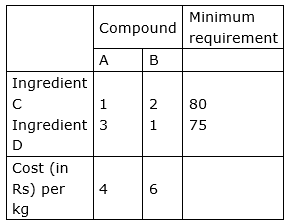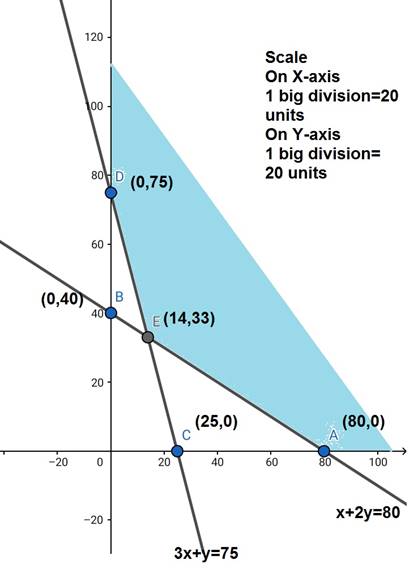A chemical company produces two compounds, A and B. The following table gives the units of ingredients, C and D per kg of compounds A and B as well as minimum requirements of C and D and costs per kg of A and B. Find the quantities of A and B which would give a supply of C and D at a minimum cost.

Let required quantity of compound A and B are x and y kg.
Since, cost of one kg of compound A and B are Rs 4 and Rs 6 per kg. So,
Cost of x kg of compound A and y kg of compound B are Rs 4x and Rs 6
respectively.
Let Z be the total cost of compounds, so,
Z = 4x + 6y
Since, compound A and B contain 1 and 2 units of ingredient C per kg
respectively, So x kg of compound A and y kg of compound B contain x and 2y
units of ingredient C respectively but minimum requirement of ingredient C is 80
units, so,
x + 2y ![]() 80 {first constraint}
80 {first constraint}
Since, compound A and B contain 3 and 1 units of ingredient D per kg
respectively, So x kg of compound A and y kg of compound B contain 3x and y
units of ingredient D respectively but minimum requirement of ingredient C is 75
units, so,
3x + y ![]() 75 {second constraint}
75 {second constraint}
Hence, mathematical formulation of LPP is,
Min Z = 4x + 6y
Subject to constraints,
x + 2y ![]() 80
80
3x + y ![]() 75
75
x, y ![]() 0 [Since production can not be less than zero]
0 [Since production can not be less than zero]
Region x + 2y ![]() 80: line x + 2y = 80 meets axes at A(80,0), B(0,40)
80: line x + 2y = 80 meets axes at A(80,0), B(0,40)
respectively. Region not containing origin represents x + 2y ![]() 80 as (0,0) does
80 as (0,0) does
not satisfy x + 2y ![]() 80.
80.
Region 3x + y ![]() 75: line 3x + y = 75 meets axes at C(25,0), D(0,75)
75: line 3x + y = 75 meets axes at C(25,0), D(0,75)
respectively. Region not containing origin represents 3x + y ![]() 75 as (0,0) does
75 as (0,0) does
not satisfy 3x + y ![]() 75.
75.
Region x,y ![]() 0: it represents first quadrant.
0: it represents first quadrant.

The corner points are D(0,75), E(14,33), A(80,0).
The values at Z at these corner points are as follows:
Corner Point Z = 4x + 6y
D 450
E 254
A 320
The minimum value of Z is 254 which is attained at E(14,33).
Thus, the minimum cost is Rs 254 obtained when 14 units of compound A
and 33 units compound B are produced.